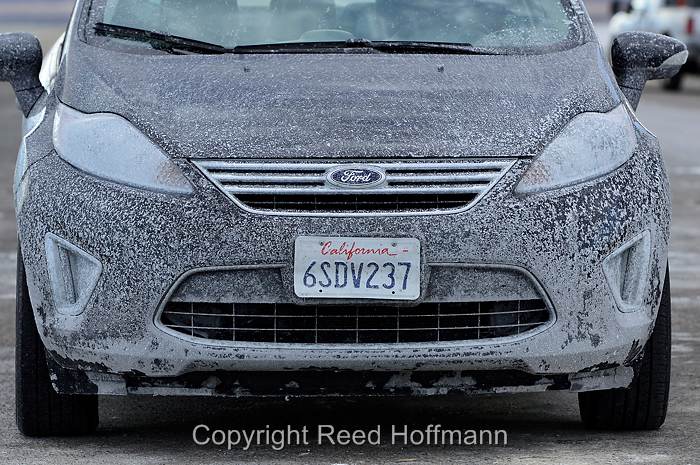Recently I was wondering why photographers are drawn to broken-down stuff. Abandoned houses, peeling paint, rusted cars, dead trees. Is there something wrong with us? I don’t think so. At least not most of us. I think the real reason is the same rationale that drives how newspapers decide what’s news. It’s the unexpected, the unusual. When everything’s working as expected, that’s not news. And that’s certainly one reason why we’re drawn to photograph certain things. They’re unusual, different, not what’s expected. Not what we normally see day in and day out, whether it’s a killer sunset or a shack. That’s why it’s easier to shoot pictures when we’re away from home. At home we’re used to what’s around us, and our eyes become calloused. We’re not “seeing” anymore.
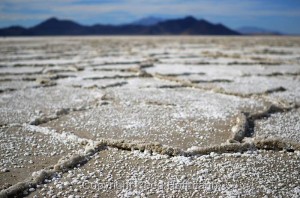
Getting low and using a 28mm f/1.8 lens wide open, I was able to keep the focus on the salt crystals in the foreground but still show the patterns of ridges and the mountains in the background. Nikon D7000, ISO 100, 1/6400, 1.8, +0.3 EV, 28mm. Photo copyright Reed Hoffmann.
I’ve just returned from a quick trip to Salt Lake City. I was flying in early and would have the first afternoon free, so did a little research and decided to drive from the airport to the nearby mountains to shoot for a couple of hours. Then after the following day’s training, I’d head out to the Bonneville Salt Flats for sunset. But on the flight in I realized I’d made a mistake. My priority should have been what’s most unique, and that would be the salt flats. So I changed plans and decided to go straight there, to have plenty of time to explore them.
Meeting my teaching partner at the airport, we grabbed our rental car, stopped to pick up water and snacks and headed out. As we drove west on I-80, the car’s thermometer read 106-degrees. Ouch. By the time we got to the flats, it had dropped to 100. We pulled in to the rest stop with the historical marker, and got out. You read about places like this, but you can’t really appreciate it until you see it. Wide open space, nothing growing for miles and miles, absolute desolation. Flat, white, mirages forming in the
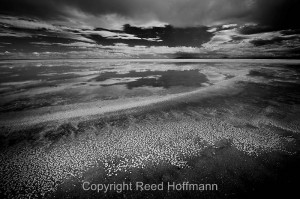
Some shallow pools of water from a passing rainstorm gave me a nice reflection. The dramatic clouds made the decision to convert to black and white easy. Nikon D3200, ISO 100, 1/125, 8, 0.0 EV, 10mm. Photo copyright Reed Hoffmann.
distance before fading into the mountains. Between the sun and the white of the salt flats, it’s so bright it hurts the eyes. But oh, what a place to take pictures – a weird, wonderful place!
The ground had crystals of salt in empty pools, small ridges formed in geometric patterns, and the classic dry, cracked look of parched earth. We spent about an hour working the area surrounding the rest stop, then as clouds moved in we decided to head to the racetrack.
Exiting the interstate, you take a paved road for a couple of miles and then it empties you onto the salt flats. Normally you can drive out to see the racetrack (a black line running on the sand for ten straight miles), but the area was closed for Motorcycle Week. That was okay with me. Watching cars coming off the salt flats reminded me of winter days in upstate New York. They were coated in salt, and not how I wanted to return the rental car. It
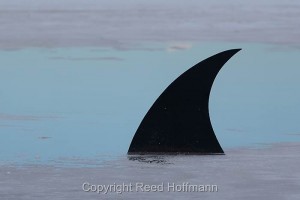
The sign said “Welcome to Shark Week,” and I don’t know what it meant, but I loved the fin someone had planted. Nikon D7000, ISO 125, 1/1250, 5, -0.3 EV, 200mm. Photo copyright Reed Hoffmann.
had rained recently, so we found plenty to shoot, working with the reflections and some rocks nearby.
From there we headed back to the interstate and turned north, taking a two-lane road up into the mountains. In the days when I worked for newspapers, one of my favorite things on a slow day was to take a road I’d never been on, just to see what was there. We followed it for about five miles, stopping occasionally to shoot. By then it was getting close to sunset, so we went back to the interstate and had a quick dinner at a small café. As we finished eating, the sky turned into a beautiful sunset. Colorful sunsets can be nice, but in my opinion, you need something else in the picture too. There was another rest area off of I-80 just down the road, and I hoped we’d find something there. I won’t say I broke the 75 mph speed limit, but I got us there in record time. As we pulled off to shoot the flats and sunset, we were blessed to find a small pool of
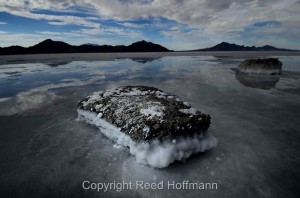
I had to wade into a pool to make this shot, but I really wanted this salt-encrusted rock big in the foreground of my picture. I held the camera about 10-inches away and used a flash to light the rock from the left side. Nikon D7000, ISO 160, 1/250, 11, -0.3 EV, 11mm. Photo copyright Reed Hoffmann.
water, and better yet, some birds. We had about ten minutes to shoot before the light was gone, which was just enough time.
Then it was time to drive back to Salt Lake City. We’d had a great afternoon, and by 10pm were checking in to our hotel. In the time we were out exploring the salt flats, we could have gone straight to the hotel from the airport, unpacked, relaxed, gone out to dinner and then watched some TV. I’m sure glad we didn’t. I can’t think of a better way to spend free time in a new place than getting out to shoot pictures. And if I’m lucky enough to find something truly unique nearby, all the better. I don’t know when I’ll get the chance to go to someplace like the Bonneville Salt Flats again, but I hope it’s not too long. And the stranger the place is, the better. Weird makes good photos!
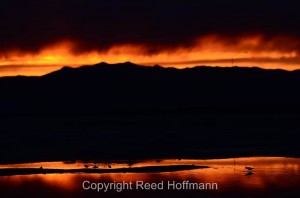
Pretty sunsets are nice, but they’re much better if there’s an added element. The birds visiting this small pool of water are what makes this shot really work. And then I heavily underexposed so you can’t see the interstate in the background, and to make the colors dark and more dramatic. Nikon D7000, ISO 125, 1/500, 4, -2.0 EV, 105mm. Photo copyright Reed Hoffmann.

